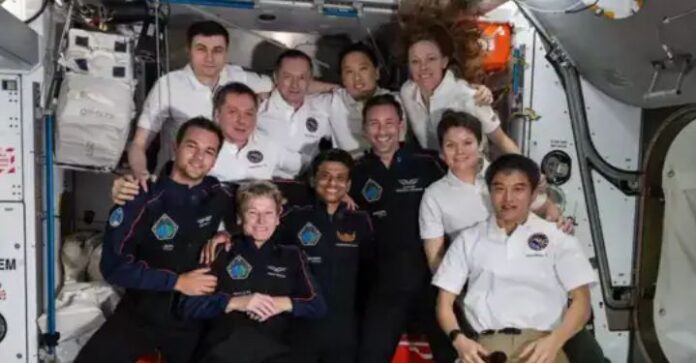July 14, 2025 – The journey back to Earth has begun for Shubhanshu Shukla, India’s representative aboard the Axiom-4 space mission. Alongside his international crewmates, the Group Captain from the Indian Air Force departed the International Space Station (ISS) today aboard SpaceX’s Crew Dragon “Grace” after an eventful 18-day orbital mission. The return leg will take roughly 22 hours, culminating in a Pacific Ocean splashdown on July 15.
This mission not only marked India’s first human presence in space in over four decades, but also highlighted the increasing role of private and global collaborations in shaping the future of space exploration.
A Momentous Undocking
At 4:35 PM IST, the Crew Dragon capsule gently undocked from the Harmony module of the ISS, signaling the official start of the return journey. Axiom-4 crew members—Commander Peggy Whitson (USA), Sławosz Uznanski (Poland), Tibor Kapu (Hungary), and Shubhanshu Shukla (India)—bid farewell to the orbital outpost after successfully conducting dozens of scientific, technological, and outreach activities.
The spacecraft slowly maneuvered away using its onboard thrusters, entering a safe departure trajectory. Over the next day, it will gradually lower its orbit in preparation for atmospheric re-entry.
18 Days of Science and Diplomacy in Space
Axiom-4 wasn’t just a spaceflight—it was a flying laboratory and a diplomatic milestone. For Shukla, the mission provided a platform to execute seven Indian-origin experiments sponsored by ISRO, IN-SPACe, and academic institutions across India.
Highlights of the scientific payloads include:
- Space farming: Studying the growth of moong beans and fenugreek in microgravity to assess their viability as food sources on future long-duration missions.
- Microbial studies: Investigating how bacteria and fungi behave in space conditions, which could have implications for closed-loop life-support systems.
- Wearable tech validation: Using glucose monitors and biosensors to track astronaut health in real time.
- AI-aided systems: Testing autonomous decision-making for onboard systems, especially during communication blackouts with ground control.
Shukla also carried cultural mementos, including a digital archive of Indian classical music, a handcrafted ISRO badge, and a small figurine of Aryabhata, the country’s first satellite.
“Aaj Ka Bharat”: Shukla’s Message Resonates from Orbit
Just before undocking, Shukla delivered an emotional message from the ISS’s Cupola observation module. His words echoed across India and the world:
“This mission is not mine alone—it belongs to every Indian who has ever looked up at the night sky and dreamed. Today, we walk in the legacy of Rakesh Sharma and fly toward Gaganyaan, Artemis, and beyond.”
He adapted Sharma’s iconic “Saare Jahan Se Achha” by saying,
“Aaj ka Bharat—fearless, limitless, and ambitious—carries the same pride into space. Jai Hind.”
The message drew applause from fellow crewmates and touched a chord with millions watching back on Earth.
Re-Entry: What to Expect
Over the next several hours, the Crew Dragon capsule will orbit the Earth multiple times as it slowly aligns itself for re-entry. The vehicle will perform a deorbit burn and begin descending at a steep angle, enduring high atmospheric friction.
- Heat shield protection: The capsule’s carbon-based heat shield will resist temperatures up to 1,900°C.
- Parachute deployment: A series of parachutes—drogue followed by main—will reduce velocity to ensure a safe ocean landing.
- Splashdown location: The recovery zone is in the eastern Pacific Ocean, roughly off the coast of California. A SpaceX ship will retrieve both crew and capsule.
Weather conditions and orbital mechanics could slightly shift the splashdown timing, but it is currently projected for around 3:00 PM IST on July 15.
Family, Fans, and a Nation Await
In Lucknow, Shubhanshu Shukla’s hometown, his family gathered early to follow the mission. His mother Asha Shukla and father Shambhu Dayal Shukla offered prayers at a temple and lit candles in hope of a safe return.
Back in Delhi and Bengaluru, ISRO scientists monitored the mission’s trajectory with quiet pride. For India’s space community, this is more than a symbolic milestone—it is the precursor to Gaganyaan, the nation’s first indigenous crewed mission expected in 2027.
Axiom’s Broader Mission: Commercial and Global
Axiom-4 is part of a larger strategy by Axiom Space to develop commercial human spaceflight infrastructure, including Axiom Station, the world’s first commercial space station currently under development.
This mission also proved the success of multi-national commercial collaborations, involving:
- NASA for docking support and ISS operations
- SpaceX for launch, orbital support, and re-entry
- ESA, ISRO, and national governments for astronaut training, medical certification, and mission planning
Peggy Whitson, mission commander, called the mission a “triumph of global science,” adding:
“Shubhanshu brought with him not just experiments, but hope. He represented 1.4 billion people with grace and precision.”
What Happens After Splashdown?
Upon recovery, the astronauts will be flown to a NASA recovery facility for medical checkups, debriefings, and data collection. Shukla will then return to India for post-mission reporting and outreach.
He is expected to address students, researchers, and space policy leaders across India as part of a broader campaign to boost interest in STEM and India’s space ambitions.
Looking Ahead: India in the Cosmos
Shukla’s journey may be ending, but its legacy is just beginning. His successful participation:
- Reinforces India’s capability in training astronauts for international missions
- Enhances ISRO’s experience in human spaceflight environments
- Builds the foundation for potential Indian collaborations on the Lunar Gateway, Mars missions, and low-Earth orbit platforms
With the Axiom-4 crew en route home and the stars still in view, India’s celestial aspirations have found new fuel. As the Dragon capsule makes its way through the black silence of space, millions wait to welcome home a man who helped bring India one step closer to the cosmos.

